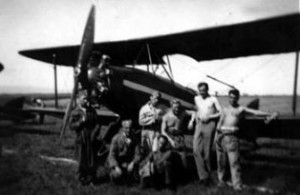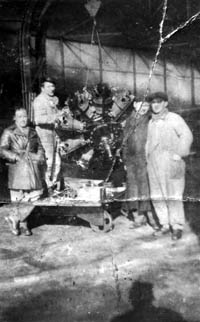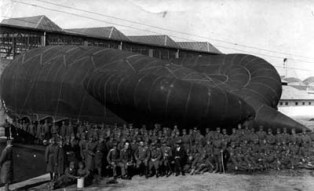Vazduhoplovstvo Vojno Organization
Vazduhoplovstvo VojnoAir Arm of the Yugoslav Kingdom had its roots in the aviation of Serbian Kingdom. After WWI on Balkan was constituted the new state which first name was Kingdom of Serbs, Croats and Slovenians but later replaced with shorter name, Yugoslav Kingdom. For a first time, units were made from material and personality from former Austro Hungary and Serbian Kingdom aviation.
 In the first period main equipment were Breguet XIV, Phonix, Rumpler, Albatros, Uci, SPAD, Nieuport, Berg and Anatra warplanes. From 1926 begun second period when the equipment became Breguet XIX, Potez XV and XXV and Dewoitine D.1. In this period ( 1926-1930) was established first larger units, as well in spring 1928 first bomber regiment ( 3. vazduhoplovni puk in Skoplje) and first fighter regiment ( 6. vazduhoplovni puk in Belgrade). The following period is from 1931 up to 1937, when Yugoslavia employed heavy bombers in its service and during that time flew new versions of Breguet XIX, Dornier DoY, Junkers G.24, Avia Fokker F.39, Potez XXV, Dewoitine D.27, Avia BH. 33 E and Hawker Fury.
In the first period main equipment were Breguet XIV, Phonix, Rumpler, Albatros, Uci, SPAD, Nieuport, Berg and Anatra warplanes. From 1926 begun second period when the equipment became Breguet XIX, Potez XV and XXV and Dewoitine D.1. In this period ( 1926-1930) was established first larger units, as well in spring 1928 first bomber regiment ( 3. vazduhoplovni puk in Skoplje) and first fighter regiment ( 6. vazduhoplovni puk in Belgrade). The following period is from 1931 up to 1937, when Yugoslavia employed heavy bombers in its service and during that time flew new versions of Breguet XIX, Dornier DoY, Junkers G.24, Avia Fokker F.39, Potez XXV, Dewoitine D.27, Avia BH. 33 E and Hawker Fury.
In the 1920 was formed military pilot school, 1. Pilotska skola, based in Novi Sad and 2. Pilotska skola, based in Mostar. In Novi Sad was also pilot school for reserve officers, established in 1920 and there were joined by school for reconnaissance officers in spring 1921. Similar school, but for active officers was established in the same year in Valjevo. Air mechanicals got its school in 1921 at Petrovaradin within Aeronautical arsenal (Vazduhoplovni arsenal). This arsenal will be later renamed in Vazduhoplovno Tehnicki Zavod (Aeronautical Technical Facility) and displaced in Kraljevo in 1927. Except of air mechanicals, in Petrovaradin were active educations program for more military profiles. From 1921 there were permanently seminars for radio telegraphic and directional finders and in 1924 was formed photographs school.
 In the 1925 in Novi Sad was formed Komanda Skola vazduhoplovnih Specijalista (Command of Aeronautical Specialist school) which had under the command following schools- reconnaissance, meteorological, radio telegraphs, photography, reserve low rank officers ( from 1926) and school of reserve air technical officers. First air command was formed in 1921 in Novi Sad and second in Mostar. Later was followed by three more commands. All commands had fighter, bomber and reconnaissance units and were directly controlled by the department of aviation from the ministry of army and navy. As a higher instance in air structure, in 1927 was formed air command, which replaced previously mentioned department of aviation.
In the 1925 in Novi Sad was formed Komanda Skola vazduhoplovnih Specijalista (Command of Aeronautical Specialist school) which had under the command following schools- reconnaissance, meteorological, radio telegraphs, photography, reserve low rank officers ( from 1926) and school of reserve air technical officers. First air command was formed in 1921 in Novi Sad and second in Mostar. Later was followed by three more commands. All commands had fighter, bomber and reconnaissance units and were directly controlled by the department of aviation from the ministry of army and navy. As a higher instance in air structure, in 1927 was formed air command, which replaced previously mentioned department of aviation.
Peacetime formation of Yugoslav military aviation was done by regulations of aviation in peacetime from 1936. On the head of that branch of armed forces was Command of military aviation which was in Novi Sad and that command was subordinated to the ministry of army and navy, except in area of training where was subordinated to the chief of general staff headquarter. On the head of the command was commandant of military aviation, in rank of general and he had the authority of commandant of army district. He was appointed by the King and by the suggestion of the minister of army and navy. Commandant had an assistant in rank of division general (and had a division under command). Assistance and help in activity, commandant got from the staff of command of military aviation. This staff was leaded by brigade general or colonel (and had a brigade under the command). General staff department is divided into the three sections; operational, scholar and adjutant. Operational section release commanding, equipping and dislocating of units and institutions and collecting information’s of foreign aviations. School section is responsible for planning and release of education and training. Adjutant section take work on personnel, release orders and keep the archive of command. There was also a technical section and they was provided manuals for equipment and control devices, maintenance of aeronautical equipment and control of the productions, overhauls and repairs done by aeronautical facilities. Engineers section project, build and maintain buildings and take on maintenance on airfields as well take on evidence of all buildings and terrains. Antiaircraft section had artillery and protection department and they study active defense measurements in country and foreigner and passive protection (balloons and nets). Civil section take responsibility of information’s of all manufacturers who could be used in military production in the event of war.
From the 1936 command of aviation was placed in new monumental building in Zemun. In that moment it had two large units submitted. First brigade with staff was in Novi Sad and had two regiments, 1. vazduhoplovni puk ( bombers) and 6. vazduhoplovni puk (fighters). First regiment was located on military “Jugovic” close to Novi Sad. Six, fighter, regiment was located on airfield “Beograd”, three kilometers away from Zemun. That was both military and civilian airfield, equipped for day or night operations. Second brigade, with staff in Zagreb, had three air regiments and there were 4. vazduhoplovni puk ( fighters), 7. vazduhoplovni puk ( bombers) and 2. vazduhoplovni puk ( reconnaissance). Fourth, fighter, regiment was based on “Zagreb” airfield on Borognaj, close to Zagreb, and airfield was for civilian use too but could not take night operations. Second, recce, regiment was based on “Rajlovac” airfield near Sarajevo and seventh, bomber, regiment was near village Ortjes, close to Mostar.
On the airfield “Skoplje” , 15 kilometers away from Skoplje, was based 3. vazduhoplovni puk ( bombers). On military/civilian airfield in Nis was 1. balonska ceta ( balloon battalion) but there were sometimes detachments from other units. There were also three air groups which were not in the structure of regiments. That was 81. samostalna grupa and 201. trenazna grupa, which was under direct control of the command of 1. vazduhoplovna brigada and was located on “Beograd” airfield. On the same field was test group which was under direct control of the Command of military aviation.
In 1937 units were divided on flying and non-flying sections. Non flying units became air bases, which took responsibility of accommodation of flight units, logistic and material security of the units. There were ten air bases, 1. in Novi Sad, 2. in Rajlovac, 3. in Skoplje, 4. in Zagreb, 5. in Nis, 6. in Zemun, 7. in Mostar, 9. in Pancevo, 31. in Bela Crkva and 32. in Kraljevo. In general, all this air bases had workshops, arsenal and mechanicals school, vehicle units, communications platoon, airfield infantry battalion, power station and meteorological station. But ninth base does not have power station, sixth base does not have arsenal within technical section and fifth which had arsenal and workshop instead of technical section. Photo units had only second base (other bases had photo personnel only). Only 1., 4. and 32. base had fuel and ammunition store.
 By the order of formations of military aviation from February 1939, in the event of war, units, institution and command will transform into war formation. Full filling of the units should be done from the operational army and in the absence they could be filled with men from army reserve. In the reason of security only Yugoslav nations could enjoy in aviation. Complete mobilization should be done in 48 hours. Firstly, on Zemun airfield would be formed Department of aviation from staff of military aviation and on the Pancevo airfield should be formed 1. and 2. paratrooper company. During the first six hours, four brigade, eight regiments, fifteen groups, thirty six combat and two ambulance escadrille would be mobile. Twenty four hours later will be mobilized staff of 1. vazduhoplovna divizija and five transport escadrille. In the meantime 607. training escadrille would transit into 65. bomber group. Finally will be mobilized command of military aviation and five liaison escadrille. Eventually 201. training escadrille should transform into the 11. group for far reconnaissance.
By the order of formations of military aviation from February 1939, in the event of war, units, institution and command will transform into war formation. Full filling of the units should be done from the operational army and in the absence they could be filled with men from army reserve. In the reason of security only Yugoslav nations could enjoy in aviation. Complete mobilization should be done in 48 hours. Firstly, on Zemun airfield would be formed Department of aviation from staff of military aviation and on the Pancevo airfield should be formed 1. and 2. paratrooper company. During the first six hours, four brigade, eight regiments, fifteen groups, thirty six combat and two ambulance escadrille would be mobile. Twenty four hours later will be mobilized staff of 1. vazduhoplovna divizija and five transport escadrille. In the meantime 607. training escadrille would transit into 65. bomber group. Finally will be mobilized command of military aviation and five liaison escadrille. Eventually 201. training escadrille should transform into the 11. group for far reconnaissance.
In the 1941 aviation of Yugoslav Kingdom was military aviation, naval aviation and civilian aviation( mobilized in military aviation). Military aviation has in formation Operativno vazduhoplovstvo ( Operational aviation), Armijsko vazduhoplovstvo ( Army aviation) and Pozadinsko vazduholovstvo ( Backline aviation). Operativno vazduhoplovstvo had bombers, fighters, far reconnaissance, liaison, ambulance and transport planes. Last three was known as pomocno vazduhoplovstvo ( auxiliary aviation). Armijsko vazduhoplovstvo had units for close support and tactical reconnaissance and operate for infantry. Pozadinsko vazduhoplovstvo consisted of Skolsko vazduhoplovstvo ( School aviation), Trenazno vazduhoplovstvo ( Training aviation) and Opitna grupa ( test group) and additional escadrille.
Operativno vazduhoplovstvo had in its mixed brigade 18 fighters and 20 bomber escadrille. Far reconnaissance had on its development and only one group existed ( with two escadrille of Blenheim).
Liaison aviation was not well developed and missed crafts. In five active escadrille there was 15 Fi156 Storch, ten Bu131 Jungman, five Me108 Taifun and some numbers of school planes. Ambulance aviation was in establishing and still the type of plane was not chosen. Two escadrille was planed but only one exist with missing equipment, with two plane RWD-13S and one Potez XXV, adopted for cargo of injuries. Transport aviation was not in developed and prior the war it was organized from civilian airline company “Aeroput”. Pozadinsko vazduhoplovstvo was not specially organized and chaotically was improvised with different kind and type of airplanes.
Skolsko vazduhoplovstvo had three pilot school and three aviation school for upgrade with 216 airplanes. Trenazno vazduhoplovstvo had 66 airplanes in ten escadrille. Opitna grupa had accepted and tested airplanes from import and domestic built and later, proceeded to operational unit.
Additional escadrille was 751. in Sarajevo, 752. in Kraljevo, 753. in Mostar and 754. in Nis and their duty was to refill units with personnel and equipment ( airplanes).
Andrija Pavlovic
Images- Srecko Bradic collection
Note- this text is extract from the book in peparation author by Andrija Pavlovic. Andrija Pavlovic was former high officer of Yugoslav Kingdom and member of General Headquater. To regret it is not possible that his amazing work on the history of the Yugoslav aviation will ever been published.





